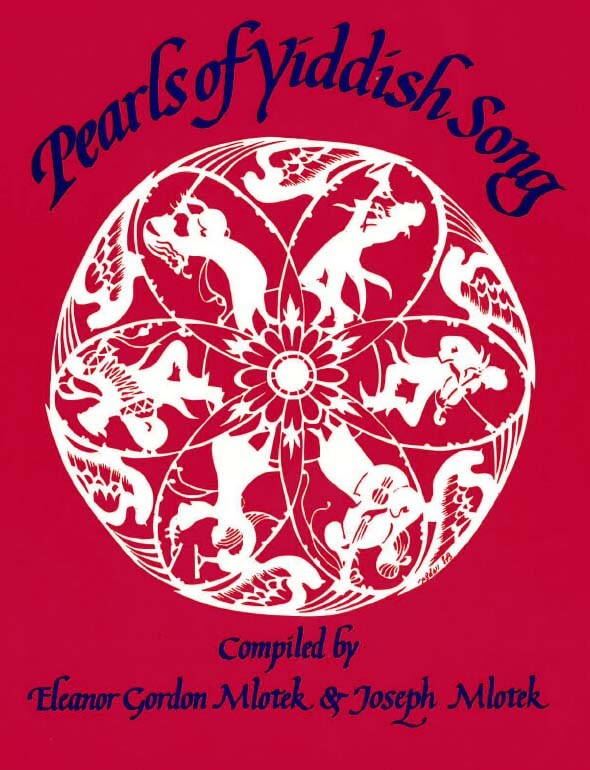Perhaps the most frequently published Yiddish song. Written by Jacob K. Sandler (186?- 1931) for M. Hurvitch’s play Brokhe, oder der yidisher kenig fun poyln oyf eyn nakht (Brokhe, or the Jewish King of Poland for One Night), staged in New York in 1896. The song, arranged by H. A. Russotto, was published in sheet music by the Hebrew Publishing Co., N.Y., 1907.
Brokhe’s popularity was due to the song which was originally performed by Boris Thomashefsky. Many singers since then, among them Cantor Yossele Rosenblatt and Al Jolson, have included the song in their repertoires. Mischa Elman also made a transcription of the song for the violin.
During World War II, “Eyli, Eyli” was sung by Miriam Eisenstadt, known as the “nightingale of the Warsaw Ghetto.” She was ultlmately shot by the Nazis. Jonas Turkow recalls:
For the tiny remnant of Ghetto inhabitants, her rendition of “Eyli, eyli, lomo azavtoni” was unforgettable. She evoked so much feeling, so much longing from the popular song, that she moved even the stone hearts of Ghetto and police officials. Her fame spread so far that when the German hangmen sent a film crew into the Ghetto to film the “life” of the Jews, Miriam Eisenstadt was forced to sing “Eyli, Eyli” in this film.
More recently, the song was one of the first recorded by Jewish singers in Soviet Russia after the thaw, when Jews were permitted once more to stage Jewish concerts.

My God, why hast Thou forsaken me?
My God, why hast Thou forsaken me?
In fire and flames they burned us.
Everywhere they shamed and mocked us.
But no one could turn us away from You, my God, nor from Your Holy Torah,
From Your Commandment.
My God, why hast Thou forsaken me?
My God, why hast Thou forsaken me?
Day and night,
I think only of You, my God.
I guard with awe
Your Torah
And Your Commandment.
Rescue me, oh, rescue me from danger
As You once did the patriarchs from their oppression,
Hear my prayer and my lament.
Only You can help.
Hear, Oh Israel, the Lord is our God, the Lord is One!
Eyli, eyli, lomo azavtoni?
Eyli, eyli, lomo azavtoni?
In fayer un flam hot men undz gebrent,
Iberal hot men undz gemakht tsu shand un shpot.
Dokh optsuvendn hot undz keyner gekent
Fun dir, mayn got, un fun dayn heyliker toyre,
Fun dayn gebot.
Eyli, eyli, lomo azavtoni? Eyli, eyli, lomo azavtoni?
Tog un nakht,
Nor ikh trakht
Fun dir, mayn got,
Ikh hit mit moyre
Op dayn toyre
Un dayn gebot.
Rete mikh, oy rete mikh fun gefar
Vi a mol di oves fun beyzn gzar,
Her mayn gebet un mayn geveyn,
Helfn kenstu dokh nor aleyn,
Shma yisroel adonoy eloheynu, adonoy ekhod!
אלי, אלי, למה עזבֿתּני?
אלי, אלי, למה עזבֿתּני?
אין פֿײַער און פֿלאַם האָט מען אונדז געברענט,
איבעראַל האָט מען אונדז געמאַכט צו שאַנד און שפּאָט.
דאָך אָפּצוּװענדן האָט אונדז קײנער געקענט
פֿון דיר, מײַן גאָט, און פֿון דײַן הײליקער תּורה,
פֿון דײַן געבאָט.
אלי, אלי, למה עזבֿתּני?
אלי, אלי, למה עזבֿתּני?
טאָג און נאַכט,
נאָר איך טראַכט
פֿון דיר, מײַן גאָט,
איך היט מיט מורא
אָפּ דײַן תּורה
און דײַן געבאָט.
רעטע מיך, אָ רעטע מיך פֿון געפֿאַר
װי אַ מאָל די אָבֿות פֿון בײזן גזר,
הער מײַן געבעט און מײַן געװײן,
העלפֿן קענסטו דאָך נאָר אַלײן,
שמע ישׂראל ד’ אלהינו ד’ אחד!
Song Title: Eyli, Eyli

First published in 1988 as Pearls of Yiddish Song: Favorite Folk, Art and Theatre Songs, this anthology contains 115 songs. Some material had never been published, while others, included in rare song collections or sheet music, were largely inaccessible. The songs presented reflect Jewish life in Eastern Europe and the United States and depict childhood, love, family celebrations, poverty, work and struggle. There are also songs from the Hasidic and Maskilic movements, songs of Zion and of America, as well as songs from the Yiddish theater.
The title of this anthology derives from the weekly two-page feature column “Pearls of Yiddish Poetry,” which the compilers Yosl and Chana Mlotek initiated in 1970 in the Yiddish newspaper Der Forvertz (the Yiddish Daily Forward). Hundreds of readers from around the world — including authors, composers, singers, actors — became co-participants in this collective folk project and recalled melodies, lines, fragments, stanzas and their variants of songs, poems, and plays which they had heard in their youth. At first, readers sent in only written material. Later, they also taped songs on cassettes, many of whose melodies had, until then, never been recorded. They also identified and supplied missing information regarding lyricists, poets, and composers and described the circumstances surrounding the songs’ origins, their dissemination, diffusion and impact.